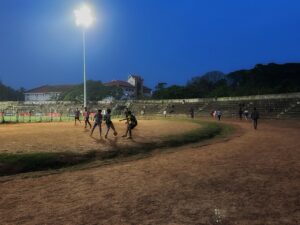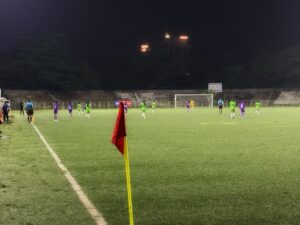In this reflective account on women’s football in Kerala, Amritha shares her uneasy feelings around the less visible Kerala Women’s League.
Amritha Mohan

It was the weekend, sometime around six in the evening in December. At the Thrissur Corporation Stadium, some people—mostly men— were on their sunset strolls, while a few others ran, jogged, or huffed and puffed doing something in between. Some couples loitered by the shade of the trees around the stadium. Sitting on the concrete steps— which partially surrounded the stadium ground— seemed like the sensible thing to do to while away time until the football match began, but as soon as I sat, the heat seared through my clothes—an aftermath of the 30-plus-degree hot afternoon. In any case, I was warming up to the ground, soaking in the heat and the people present, some of whom looked like daily walkers/runners, chit-chatting their way through the exercise. A middle-aged woman, who seemed to be enjoying her leisure, and in whose proximity I sat, casually asked me what the time was. I answered, and asked her whether she knew about the football match that was going to begin soon. “What, here?” she asked, incredulously. I smiled feebly, slightly empathising with her, and signalled towards a flex board that announced the Kerala Women’s League (2023-24), the top-division league for women footballers in the state.
And I wondered, how would she know? Even I was here only because I made a series of phone calls to the organisers concerned, trying to decipher the date and time of the event. When I enquired with them about practicalities such as schedules and fixtures to finalise my travel plans the day before, I was asked to “follow their socials” and just wait, only to be informed personally that the football league had been postponed, and will begin four days later. I remember feeling uneasy and unsettled, because if somebody (like me) actually turned up on the date they publicised on their social media, they would be in for a rude surprise. But then, it looked like not many were surprised because after all, who watches women’s football in Kerala?

Such a question needed to be asked, especially as the inaugural event of the 2023-24 Kerala Women’s League for football happened without much fanfare, in the presence of a few dignitaries. It was doubtful whether any media offered to cover these matches; apart from the tournament’s and the playing clubs’ official social media channels, there wasn’t much noise about the whole sporting event. Announcements were sparse; match commentary was non-existent. Some of the spectators at the ground, who later ended up watching the match, simply happened to be there, they told me. But at the same time, a significant few continued to trickle down and leave, slowly and unceremoniously, as the game played on. And a few other spectators, who were women, turned out to be players from other clubs who were keen to watch their competitors.
I try hard to stop myself but it is difficult to not compare. I come from Kannur, in Kerala’s Malabar, a region that is often considered famous for its football culture, specifically Sevens Football. A lot has been said about the region’s “football-crazy” fans; this has been well-documented in popular media, documentaries, films as well as academic discourse. In the narratives around football, the sport has often been likened to “emotion” and “passion”, as something that is universally capable of evoking strong feelings, as something that holds the community together and fosters a sense of belonging. Such feelings are easily palpable, as I have experienced, if one were to watch a Sevens football match here. As Veena Mani and Mathangi Krishnamurthy (2021) note, the atmosphere at a Sevens football match is nothing short of cacophonic, and replete with loud announcements, shrieks and drum beats (p. 147). This begs the question: if a region and the communities therein are capable of eliciting and exhibiting such intense emotion for a sport like football, why was that absent when the players are women 1

It is also not that Kerala was alien to women’s football. As I spoke to veteran women football players as part of my fieldwork, it was evident that Kerala did have a culture of watching and cheering on women’s football in the 1980s-90s. These were called “Exhibition” matches, where women players—once the dates for the tournament were set—took on the effort to form random teams and play against each other. Such matches were commonly held as part of most football tournaments held across Kerala. Usually, these would happen in that lull between two men’s Sevens football matches, or sometimes during its unexpected breaks. “It was our homemade version of a women’s football tournament”, says S. Lalitha, a veteran football player from Thiruvananthapuram. “Although it was conducted during break-time, as some form of entertainment, if you will, it was quite an encouragement for us as players, to witness a crowd that shouted our names, to play in a gallery that thronged with spectators. We’d hear announcements booming with our names,” she reminisced. Football coach Seena C.V from Ernakulam, who was also formerly an international player, echoed the same sentiment: “It was a thrill to feel so many eyes and ears cheering for me. Some would even garland me with cash after the match. That energy was something else,” she says. Similarly, a photograph 2 from the 1987 Nehru Cup at the Kozhikode stadium reveals how the stadium had a designated gallery just for women, and how women were visible spectators of the sport in Kerala. These instances further demonstrate the slow transformation of a gendered culture of football spectatorship as well as play in Kerala; as veteran football player G. Ayona noted: “Women have much more exposure and opportunities to play now than before, which is welcoming, but it feels like an active culture of watching and showing up for women’s football is lacking now—it certainly seemed different back when I played”.
Cut to the Women’s League today, one wonders why this is not replicated, if not redesigned, in tandem with the resources available at present. It is a common sight (and sound) in Kerala: loudspeakers, tied onto jeeps trudging through its narrow village roads, enthusiastically blaring announcements of Sevens football matches. I too wished to hear the names of a few women footballers on the loudspeaker but did not hear any. However, this is not an isolated event: I witnessed a similarly related situation at the senior women’s inter-district football championship held in October 2023, in Kasargode, where there were no announcements, and no noise really, to at least let people know that women were playing football here. When the ball went outside the ground during a game, the players themselves crossed the fence to retrieve it—and not the ball boys (or girls). It was as if a lukewarm carelessness permeated the whole atmosphere, as women went about their business, playing football with the cards they had been dealt with.

By posing these questions, my intention here is only to make sense of this discomfort and uneasiness I felt, as I watched these scenes unfold before me. Something was not right, and in saying that, I may be adding to the picture of deficit, doom and gloom, one which is often (rightfully) characteristic of the discourses around women’s sports in India. It is true that sportswomen continue to struggle for their right to safe workplaces, equal opportunity and a dignified existence in the “hegemonically masculine” field of sport, encumbered by structural issues that were identified at least three decades before (Birrell, 2000; Bryson, 1987)—and the Olympian wrestler Sakshi Malik’s resignation is a recent case in point. But the fact that there is an active Women’s League for football in Kerala is a sign that things are changing. I also do not want to end this on a hasty note by throwing in a few solutions; like a quick bandaid on a problem that demands systemic and deep-rooted surgery. For one, I do believe that more money can solve some of these problems. But it is also important that we keep asking: in a culture that is popular for its encouragement towards football, why not watch women’s football? And as Shamshad Hussain (2022) asked, why aren’t more women in Kerala on the turfs, playing?
These questions are also coloured by my own experiences in football: at the central university of Hyderabad where I studied and played (for a very short while), plenty of students actually turned up to watch our matches, sometimes even late at night. As a beginner in the sport, it was heartening for me to experience a crowd that was keen to watch us play. Whether it had more to do with the university’s urban, collegial atmosphere than women’s sport in general can be a question. But as the veteran players themselves have mentioned, the energy that the spectators bring to the ground, matters. Announcements and commentary matter. The applause, the collective sighs—it may cost close to nothing (or maybe a little something if it is a ticketed event) for the spectators, but may mean the world to the players. A little more cheer for women’s football is necessary— for it may help us reclaim sporting cultures that existed in the past, and open up the ways in which we understand and enjoy women’s sport and leisure.
References
- Birrell, S. (2000). Feminist theories for sport. In J. Coakley & E. Dunning (Eds.), Handbook of Sports Studies (pp. 62-77). Sage. https://dx.doi.org/10.4135/9781848608382
- Bryson, L. (1987). Sport and the maintenance of masculine hegemony. Women’s Studies International Forum, 10(4), 349–360. https://doi.org/10.1016/0277-5395(87)90052-5
- Hussain K.T., S. (2022, November 22). Turfukalil Penkalisanghangal Illathathenthukond [Why there are no women sports groups on the turf]. Truecopy Webzine.
- Kumar, M. (Director). (2022). Maitanam: The story of football in Kerala [Film; Documentary]. FIFA+ Original Production.
- Mani, V., & Krishnamurthy, M. (2021). The Work of Sporting Bodies: Football and Masculinity in North Kerala. Verge: Studies in Global Asias, 7(1), 147-169. https://www.muse.jhu.edu/article/801706
- Rajagopalan, R.M. (2017, January 19). An enduring football legacy: Malabar’s obsession with Sevens. The NewsMinute.
- Selvaraj, J. (2023, December 21). Sakshi quits wrestling as close associate of Brij Bhushan becomes new WFI president. Sportstar.
About the Author: Amritha Mohan is a writer and researcher from Kannur, Kerala. She is currently pursuing her PhD from Monash University (Australia), and her doctoral research investigates women’s experiences in sport and physical cultures in Kerala (namely football, Kalaripayattu and athletics). Gender, physical cultures/sport, and media-making are some of her research interests. You can reach her on Twitter, Instagram or email at amrithamohan.research[at]gmail.com.
